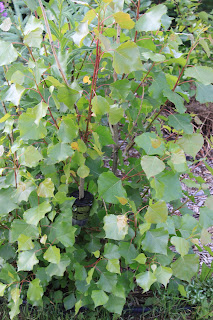Because of the large volume of vegetables we get from the garden, it is impossible to eat everything fresh. Last year to preserve our harvest we stored the carrots and potatoes in the cold room, canned the excess tomatoes, pickled the beets, and froze the peas, beans, turnips, spinach, swiss chard and remaining zucchini. In order to preserve the taste and quality of the vegetables that were frozen (excluding the zucchini) we blanched them first.
What is blanching? Blanching is a cooking process which is intended to enhance the color, flavor and texture of vegetables. Blanched vegetables are quickly cooked in boiling water (or steamed) and are then “shocked” by being plunged into an ice cold bath that immediately stops the cooking process. When blanching vegetables they are not cooking completely, the cooking process is merely started and then abruptly stopped.
Blanching vegetables before freezing is highly recommended. Blanching will neutralize any bacteria and enzymes in the food which could cause it to go bad. If done properly, it will also ensure that your vegetables stay flavorful and colorful in the freezer. If vegetables are frozen without being blanched they tend to discolor and the thawed product will likely be a mushy, ill tasting mess.
Over the past few years I’ve learnt the art of blanching vegetables. Here are a few key points that I’ve learnt.
1) Not all vegetables are blanched for the same amount of time. Different preparations also affect the blanching time. If you blanche vegetables too long or not long enough they won’t freeze well and your time and work will have been wasted.
(I was originally going to include a chart of vegetables and blanching times but the list became quite extensive. It is best to research to necessary blanching time before getting started: my most reliable source is my Joy of Cooking Cookbook, but if my laptop is handy I usually head straight to the internet. Be careful though because not everything on the internet it correct!)
2) Have lots of ice and don’t be skimpy with it.
3) Be 100% prepared before you start. Before I start I make sure of the following: my vegetables are cleaned, chopped and ready to go, I have the biggest pot I can find ¾ full of water heating, a kettle of hot water to top off my pot if needed, the biggest bowl I can find full of super cold water and ice, extra ice, strainers, a spare bowl, something to take the veggies out of the boiling water, and a timer.
We have an Eastman Outdoor Wok Burner that we use when we do our blanching. It would be nice to be inside in the kitchen but the burner works incredibly fast and all the “wet” mess is left outside and I don’t have to worry about getting water on the hardwood.
Blanching Steps:
1) Once your water is boiling, place a batch of the vegetables into the boiling water for the desired time. Make sure your vegetables BOIL for the specified time. If you try to do too much at once you’ll reduce your water temperature and it’ll take longer to recover. In order to blanche properly, your water must be boiling for the specified time. If your water cools, wait for it to come back to a boil before starting your timer. (When you blanche multiple batches, depending on the vegetable, your water may get dirty or foamy. If this happens you should dump it and start again with fresh water.)
2) Once the blanching time has expired, remove the vegetables quickly and carefully from the boiling water and place into your ice water. (I use a Chinese Brass Spider Skimmer to scope and strain the vegetables before placing them in the ice water. The more hot water you can remove from the vegetables before placing in the ice bath the better as the hot water will warm your ice water therefore slowing the cooling process. Because I’m outside I don’t care about getting water on deck, if you are inside hold a bowl below your scope to catch the hot water.)
3) Leave the vegetables in the ice bath until they are completely cool. It is best to wait to blanche more vegetables until your ice bath is empty (unless you have multiple ice baths). I usually eat a piece of the vegetable to see if it’s completely cool.
4) Once cooled, remove from the ice bath and place in a strainer to drain.
5) Once drained, portion and freeze. When I portion my vegetables I take a dinner plate and put how much I think one person would eat on the plate, double it (there’s only two of us) and then in the bag it goes. (I vacuum seal everything.) Sometimes I use my scale to ensure equal portions but because of the residue water in some vegetables (i.e.: Spinach & swiss chard) the scale isn’t always a good gauge to determine equal portions.
Blanching can be timely process, especially if you have lots to do, but well worth in it the end.
Ensure you have lots of time to complete the task before starting so you don’t end up like me blanching and freezing vegetables at 10:00 pm on a Sunday night. J
Here are some pictures of when I blanched the spinach earlier this week.
 |
| Removing the spinach from the soaking tub |
 |
| The Set-Up |
 |
| Boiling the spinach |
 |
| Removing the spinach from the boiling water |
 |
| Placing the spinach in the ice bath |
 |
| Spinach cooling in the ice bath |





































